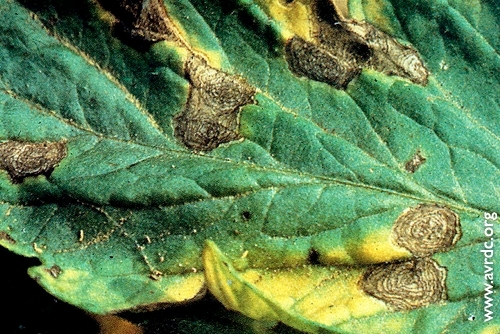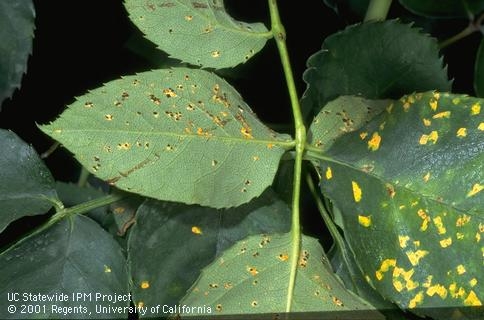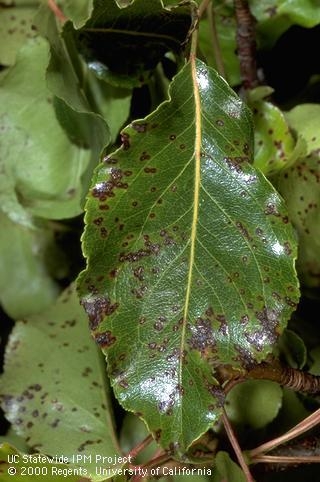Advice from the Help Desk of the
UC Master Gardeners Program of Contra Costa County
Client: I'm having some early summer problems in my garden. I'm reluctant to use pesticides in my garden since I have several small children. Would you please provide some recommendations to either cure and/or minimize the problems:
- Tomato plants are doing reasonably well but there are some funky looking lower leaves that I'm concerned about.
- My roses' leaves are mottled with brown-red markings.
- The flowering pear tree's leaves are mottled and dropping; an arborist recommended injecting a chemical into the tree to cure the problem
- I suspect that my garden soil is too alkaline (i.e. previously tested pH@7.1). How can I test it and what can I do to reduce pH? Will just adding compost reduce pH?
UCMGP's Help Desk Response: Thank you for the photographs, which were very helpful. Our responses follow:
Tomato Early Blight Infection
Roses: Your roses are infected with rust, another common fungal disease in our county. Rust is favored by mild, moist conditions, and is less common during hot weather. However, once a leaf has become infected, it will not recover, and many infected leaves will drop prematurely. Avoid overhead watering or splashing onto leaves. Fungicides can protect new growth but do not eradicate the fungus from leaves that are already infected. Commercial products (when labeled for the care of rose rust) as well as Neem oil should be effective as a preventive when used before infection starts. Clean up all fallen leaves and put them in your green waste container (i.e. do not add to the compost pile). Since one of your roses is almost completely defoliated, you may want to consult with a rose specialist. You can find one here: http://www.ncnhdistrict.org/CRs/districtcr.html. Rust resistant roses are available. Additional information on rusts can be found here: http://ipm.ucanr.edu/PMG/GARDEN/PLANTS/DISEASES/rusts.html.
Flowering Pear Tree: The photograph from the flowering pear confirms that it is infected with Entomosporium, another fungus that is spread by splashing rain. http://ipm.ucanr.edu/PMG/GARDEN/PLANTS/DISEASES/entomoslfspt.html. We do not think that this disease warrants fungicide treatment. I do not know what chemical the pest company was Infected Evergreen Flowering Pear
all pictures from ucanr.edu
Soil pH: Home test kits for soil are fairly reliable as long as the instructions are followed carefully. A pH of 7 - 7.5 is borderline satisfactory, but may go up over time because our municipal water tends to have high pH. We recommend that you wait until the plants have been harvested and then add garden sulfur to the soil in the fall according to label directions. Lowering the pH with sulfur takes time (i.e., months), so you must be patient. Adding compost will not lower the soil pH.
I hope that this information is helpful. Please do not hesitate to contact us again. Good luck on a successful summer garden.
Editor's Notes: It is likely that the tomato, rose, and flowering pear tree problems may have been caused by the late rains creating conditions conducive to fungus: cool, humid conditions. Warmer, drier weather should minimize these types of fungus infestations provided there is adequate air circulation and not overhead watering early evening.
Help Desk of the UC Master Gardener Program of Contra Costa County (JL)
Note: The UC Master Gardeners Program of Contra Costa's Help Desk is available year-round to answer your gardening questions. Except for a few holidays, we're open every week, Monday through Thursday for walk-ins from 9:00 am to Noon at 75 Santa Barbara Road, 2d Floor, Pleasant Hill, CA 94523. We can also be reached via telephone: (925) 646-6586, email: ccmg@ucanr.edu, or on the web at http://ccmg.ucanr.edu/Ask_Us/ MGCC Blogs can be found at http://ccmg.ucanr.edu/HortCoCo/ You can also subscribe to the Blog (//ucanr.edu/blogs/CCMGBlog/).
Posted on
Monday, June 20, 2016 at
12:07 AM


